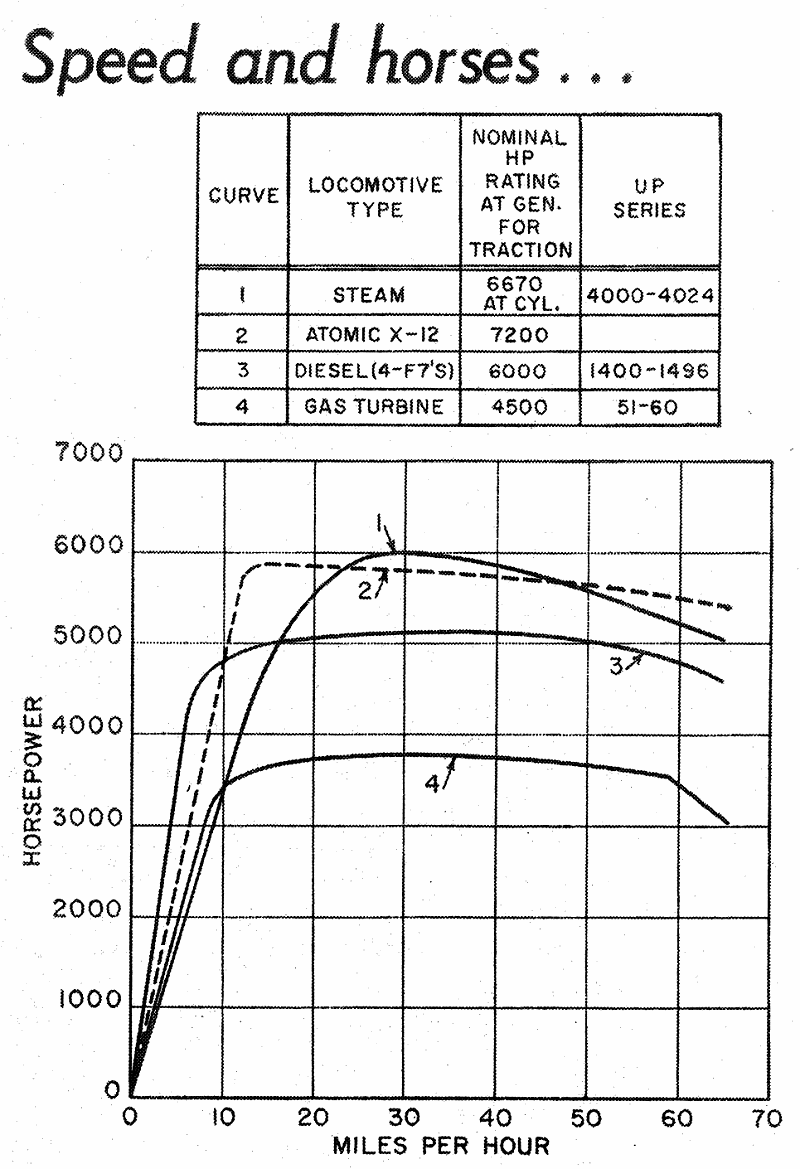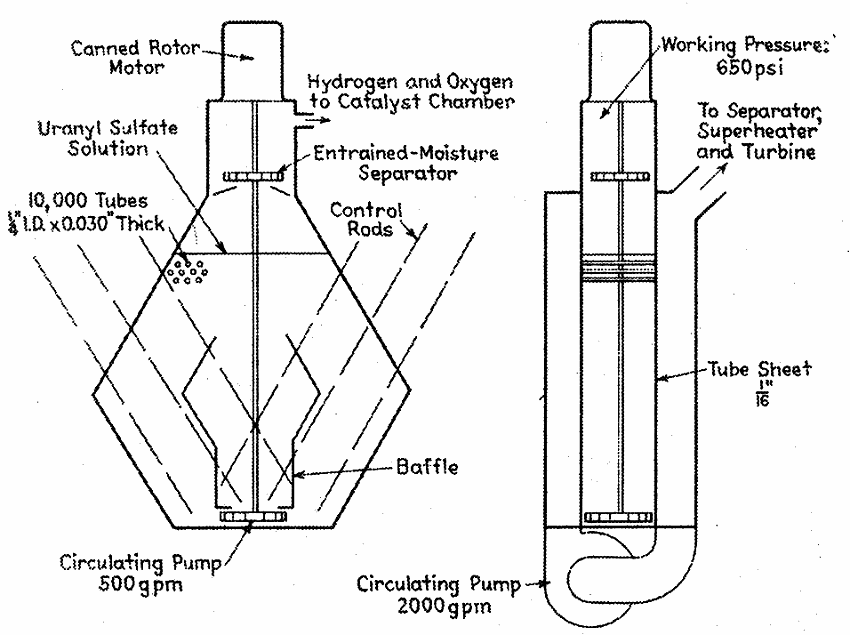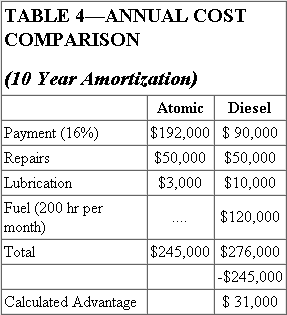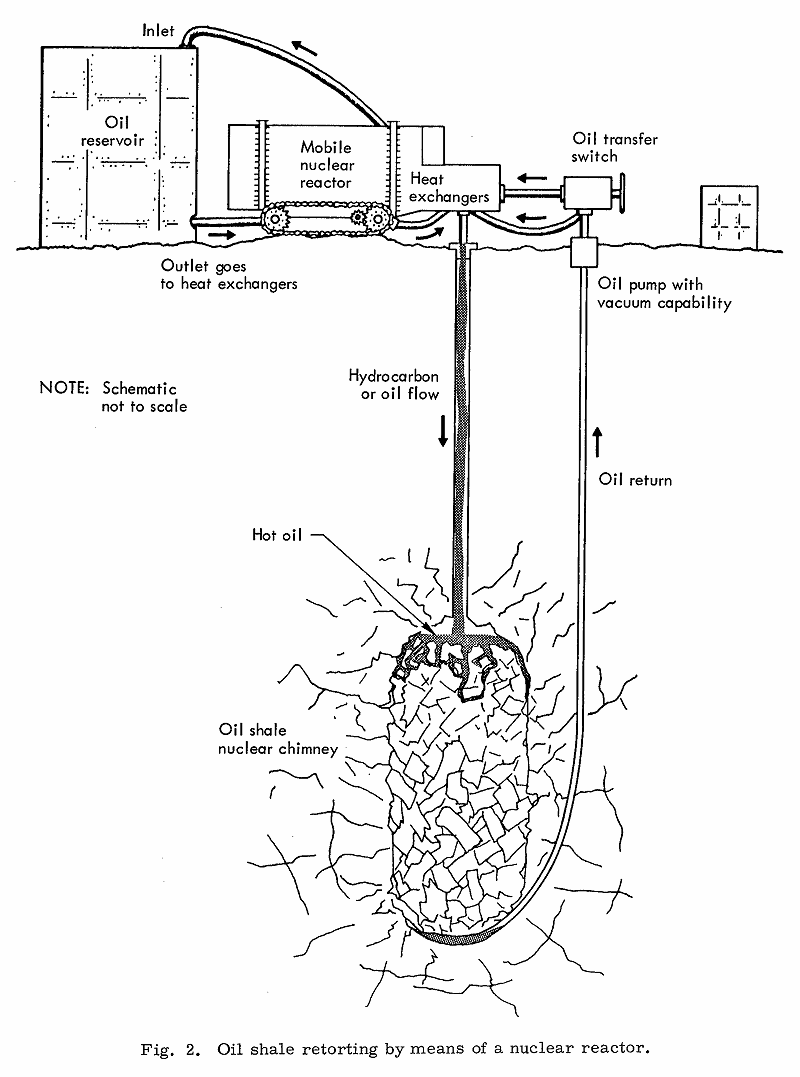X-12
Application: Atomic-Powered Railroad Locomotive
Country: United States
Status Paper Plan
Source: June 14, 1954 RAILWAY AGE -- What Will the Atomic Locomotive Be Like?
 Exterior View of X-12
Exterior View of X-12
 Interior View of X-12
Interior View of X-12
What it would take to build an atomic-powered locomotive is outlined in the following summary of a report by Dr. Lyle B. Borst, director of research of the University of Utah, presented at a meeting of the Atomic industrial Forum in New York.
The locomotive design was worked out by graduate students at the University of Utah, assisted by members of the faculty and representatives of manufacturers and railroads. Such a locomotive has been found technically feasible. The design considered would be a 7,000-hp unit, having 12 driving axles and a total length of 160 ft.
The reactor would be of the water boiler design. 2 by 8 by 3 ft, having an output of 30,000 kw of heat in the form of 250 psi steam. Contaminated steam would be used to operate a conventional condensing turbine, the heat being rejected through finned radiators to the atmosphere.
Power transmission would consist of geared generators and conventional traction motors. Electric locomotive performance would be achieved because of the overload capacity of the reactor. A short-time output of 9,000-12,000 hp could be attained.
Economic studies are necessarily incomplete in the absence of fuel costs (i.e. the price of Uranium 235). If U233 costs were less than $7 per gram, the locomotive would compete with present diesel units under average present operating conditions. If U235 costs were less than $25 per gram, the locomotive could compete with equivalent diesel power under optimum conditions of load and service.
Problems of health and public welfare are considered technically soluble, although the exact arrangements have not been detailed.
Duty and Specification
The only real economic incentive for atomic power comes from a possible reduction in fuel costs. This is particularly true of the first few locomotives. At a future date, if atomic units replace diesels, there may be further economies due to the retirement of fueling equipment in the same fashion that diesels have retired extensive watering facilities. Atomic units will require infrequent refueling, but it must be done at an elaborate central facility.
An important characteristic of a reactor is that its output is not proportional to its expense. A 1,000-kw reactor may require 5 ft. of shielding whereas a 10,000-kw reactor might require 5.5 ft. Each must have about the same control system and safety devices. The initial quantity of fuel, required might differ by as much as 10 per cent. However, the heat exchange system is proportional to power rating, and its cost may increase rapidly with output, The locomotive proposed, is, therefore; as large a unit as would appear to find use in present railroad practice. Reactor and shield weight probably cannot be reduced much below 400,000 lb. With chassis and necessary auxiliaries, it is bound to be a large and heavy locomotive.
Maintenance costs associated with the reactor are likely to be low. Maintenance within a reactor shield is prohibited by the radioactivity. The reactor must therefore be designed with such care that failures within the shield are extremely improbable. In the event of a failure of the reactor, the locomotive can be expected to be out of service for months and perhaps years. Other equipment—turbine, heat exchanger, generator and motor—would be of conservative conventional design and would entail normal maintenance. The turbine would presumably require less maintenance than reciprocating diesel engines of comparable power.
Because of its size and cost, the atomic locomotive will seriously lack flexibility. In order to compete with other motive power, it must haul heavy loads at high speeds with short turnarounds, In principle, it should be capable of simple operation. There is no reason why during normal operation a steam pressure gage, ammeter and throttle cannot be the operating instruments.
Reactors are capable of virtually infinite power output. They are limited in practice only by the requirement of heat removal. If the proper heat extraction and energy conversion system can be developed, the atomic locomotive should be capable of electric locomotive performance.
The continuous duty power selected, in the proposed design is 7,000 hp, to compare with four 1,750-hp diesel freight units. An output of 10,000 hp or higher could, probably be available for short time duty. A conventional condensing steam turbine was selected as the prime mover, geared to four a-c generators. The steam pressure conditions selected were 250 psi saturated (superheat is quite possible) and 3 psi exhaust pressure.
Twelve motor-driven axles give a reasonable wheel arrangement. Using an axle loading of 60,000 lb, the complete unit, can weigh 720,000 lb. Motor ratings for continuous service are then 600 hp per axle, about equal to the Union Pacific gas turbine units.
Permissible dimensions accepted, for design are 60 ft between truck centers, 10 ft width, 16 ft height above rails, and 6-in, clearance above rails. Present plans call for a trailer to carry the condenser cooling radiators.
General Description
The locomotive as presently visualized is illustrated, It consists of two units having an overall length of 160 ft. The traction unit would lead, the heat exchanger unit trailing. This order might be reversed if desired.
Of this total installation, the power is derived from a reactor vessel measuring about 1 by 3 by 3 ft. This reactor (including pumps, steam, separator and recombination system) is surrounded by a massive shield 4 ft thick weighing approximately 400,000 lb.
The turbine receives steam through a spiral steam line (to prevent leakage of neutron and gamma ray radiation), and operates on slightly radioactive steam. The exhaust steam is condensed in a tubular condenser extending to the top of the cab. Condensate is pumped, back into the reactor. Condenser water is pumped to the second car and then through heavy duty finned radiators where the heat is transmitted to a large stream of cooling air. The turbine would be geared for generators on both sides of the cab. The generators and gears would constitute part of the reactor shield, and would not contribute additional weight to the locomotive.
The shield would constitute the center panels of a heavy duty bridge truss which would transmit its weight to the traction assemblies.
Auxiliaries such as train-heating steam generator, dynamic braking system, motor cooling blowers, auxiliary a-c generator, etc., would be placed in appropriate positions.
The anticipated performance of the proposed unit, designated X-12, with that of steam, diesel and gas turbine units of comparable ratings is compared in the charts.

 Speed-Horsepower curves for Union Pacific types of steam, diesel-electric and gas turbine-electric locomotives and for the proposed atomic locomotive.
Nature of the Reactor
Speed-Horsepower curves for Union Pacific types of steam, diesel-electric and gas turbine-electric locomotives and for the proposed atomic locomotive.
Nature of the Reactor
 X-12 Reactor Diagram
X-12 Reactor Diagram
 X-12 Reactor Loop
X-12 Reactor Loop
(1) Physical Description: The vessel to contain the liquid fuel, which is an aqueous solution of oranyl sulphate, must be able permanently to withstand high temperature and pressure, corrosive liquids, and very intense radiation. It must be absolutely leak proof; and it must be made of a material whose nuclear properties will not adversely affect the fission chain reaction. High grade stainless steel fulfills the reactor's structural requirements.
The shape chosen to contain the liquid fuel, or "soup" as it is frequently called, is a hexagonal slab. Adjacent to each of the two hexagonal faces is a water reflector. The two reflectors are connected by 10,000 heat transfer tidies which perforate the soup vessel. Note that 40,000 welds will be required to install the 10,000 tubes, each of which will consist of two concentric stainless steel tubes of 0.015 in. wall thickness, The water which circulates through the tubes and reflectors serves a dual purpose since it is the source of the steam for the turbine and an essential part of the nuclear reactor.
The vessel extends above the hexagonal volume occupied by the soup to provide space for expansion, moisture separation, and a recomposition chamber for the hydrogen and oxygen resulting from radiation decomposition of the water. In the soup volume portion of the vessel are the soup circulation equipment and the control rods. Circulation of the soup may be accomplished by a system of baffles and a circulation pump. The control rods which consist of sheets of material of the appropriate nuclear characteristics, are perforated to maintain circulation. Pertinent, data appears in the accompanying Table 2.
Since the soup will be very radioactive, corrosive, and under higher pressure than the reflectors, double wall construction of the soup vessel is proposed to satisfy the leak-proof requirement Air or water can be passed continuously through the space between the walls and then through a radiation detection device, where an increase in radioactivity would indicate a leak in the inner wall. Then remedial steps could be taken before a leak developed in the outer wall (which would result in contamination of the turbine-generator system).
The reactor will be at: the center of a 10 by 15 by 15 ft shield and oriented so that the hexagonal faces are perpendicular to the direction of motion of the locomotive. This provides a distance of 4 ft from the outer face of the reflector to the face of the shield adjacent to the cab.
The shield material will, be approximately 50% steel and 50% hydrogenous material of about unit density. The nuclear requirements are that the high and low density materials appear in alternate layers.
To minimize the wreck hazard, it is proposed that the shield be designed as a series of containers, then each steel layer of the shield would be a potential container if the soup vessel should rupture.
(2) Nuclear Properties: The proposed nuclear reactor is a homogeneous thermal reactor. Uranium-235 is the fissionable material; water is used for the moderator, reflector, and coolant.
The uranium, in the form of uranyl sulphate, is dissolved in the water moderator to give a homogeneous solution. The choice of this compound is based on its high solubility and the radiation stability of the sulphate ion compared with other anions.
The moderator water will undergo radiation decomposition into hydrogen and oxygen at the rate of 32 gallons per second, when operating at full power. At this rate., 10 per cent of the moderator would be lost in 13 minutes operation at. full power. Thus, the hydrogen and. oxygen must be recombined and the water returned to the soup in order to maintain a constant moderator-to-fuel ratio.
When gases rise from the soup through the moisture separator, they will be pumped to a catalytic combustion chamber and recombined, and water will be returned, to the soup. The rate of energy release from recombination will be 500 kvv when the reactor is operating at full power.
(3) Heat Transfer: The 10,000 tubes which perforate the soup present a surface of 806 sq ft for heat transfer. For a temperature difference of 60 deg F this is reasonable for a forced convection system.
Since the circulation in the reflector is much too fast to permit separation of steam and water by gravity, a steam separator must be included. A system in which the direction of the steam is changed to force the water out centrifugally should be adequate.
The heat produced after shut-down can be dissipated by continuing to operate the reflector circulating pump.
(4) Control: The fission chain reactor is controlled by positioning sheets of a material which has a very high neutron absorption cross-section. Boron or cadmium steels are usually used. For this reactor, the control sheets must he perforated to permit circulation of the soup. In addition, the control rods must be designed so that a sudden change in acceleration, resulting from a wreck or other emergency, will cause them to fall into place by gravity.
Starling up the reactor is accomplished by removing the control rods. When the desired power level is attained, the rods are positioned to make the reactor "critical" - which means the chain reaction is just maintained. Thus, starting is not instantaneous, but a certain time is required to attain the desired power. Similarly, when the control rods are inserted, a period of time is required for the chain reaction to die out, and it is necessary to provide for heat dissipation after shutdown.
(5) Refueling: The build-up of fission products in the soup introduces an extreme radiation hazard in the refueling operation. This necessitates a highly specialized fueling station using remote control methods. A chemical processing plant may be included, or the spent fuel sent elsewhere for separation of the remaining U235 from the fission products.
Since the reactor can operate for a comparatively long time before refueling, the high cost of the fueling station will be offset to some extent by the need for possibly just one station.
The Turbine
The operating conditions used in this discussion are listed in Table 3. It would be desirable to find a method in which saturated steam was not used. Superheat might be achieved by utilizing the heal; potential of the reactor shield. This would involve a system of elaborate piping throughout the shield, and such a proposal is not considered in this report.
A final moisture content of 21 per cent in the latter turbine stages would cause excessive erosion of the blades of these stages. Some system making use of a steam separator might be examined in a future re-evaluation, but for the. present report the conditions stated are used in the design data.
Since the turbine is about 25 per cent efficient, and since the input heat is 100 million Btu per far, the turbine uses about 25 million Btu per hr.
The remainder, 75 million Btu per hr, would be dissipated in the condenser, which would be arranged with the pipes running from side to side having a total width of six feet. The cooling water from the radiators would be piped into one side of the condenser, and removed on the opposite side, flowing horizontally through the pipes.
A feed pump at the bottom of the condenser would pump the return water to the reactor. This pump would have to be capable of pumping 250 gal per minute.
Heat Transfer
The feed water to the reactor-boiler must be a closed cycle. This means the degraded steam from the turbine has to be condensed before it is fed back into the reactor. The condenser is a horizontal-tube surface condenser, with water as the cooling liquid. The volume of cooling water required is so large, 300,000 gal per hour, that it must be conserved. Radiators, mounted on a second unit, will have to be used to cool the condenser water by dissipating the heat to air,
Electrical System
The transfer to the twelve locomotive axles of the 7,000 hp produced at the turbine shaft is to be accomplished by an electrical system. It will consist of a doubly symmetrical, double-redaction gear set giving a speed reduction of 6.25 to 1 from turbine to generator and of four separately excited DC generators and twelve traction motors, one driving each axle,
The generators are to fit a symmetrical spacing on either side in the rear of the reactor shield, with two generators on either side, one above the other.
Contaminated Turbine
If a closed steam cycle is used, there is no reason why the turbine should not operate on steam generated within the reactor. Such steam will inevitably carry radioactivity and will contaminate the turbine. The level of radioactivity in the region of the turbine would not compare with the level within the reactor, so that no shielding has been shown in the drawing. Maintenance of the turbine will be rendered more difficult by the presence of contamination. The ideal design would call for a zero-maintenance turbine.
Startup Procedure
Reactor accidents up to the present time have never occurred in a stably operating reactor. They have all occurred in connection with reactor startup. A reactor stably operating at full power, if properly designed, will respond to changes of operating conditions in such a way as to reestablish the initial conditions.
The establishment of a chain reaction is a tricky and time consuming operation. Reactor shutdown is simple. Rods of neutron absorbers are inserted and that is all there is to it. Reactor startup requires a trained and experienced operator in addition to high quality instrument and control systems.
Each, reactor type has typical startup characteristics. In the case of the proposed reactor, startup should probably be comparatively quick and easy. In predicting the characteristics of the present locomotive, it would be unwise to assume that the locomotive could be ready for service in less than half an hour after a man went aboard.
During a run or at anytime when an operator is present, the reactor could be reduced in power to perhaps one per cent of the full power. Rise to operating power would be easy and quick. If the turbine were idling, the power required might be five per cent.
It is only when the locomotive is left in the yard unattended that the reaction must be thoroughly quenched with shut-off rods. Thereafter the chain reaction must be reestablished under rigid supervision.
What About Accidents?
In the case of a wreck, the first and all important operation which must be carried out with absolute assurance is to shut the reactor off. Safety devices must be devised so that under any imaginable situation the chain reaction will be stopped.
The principal criticism of a reactor of the type described is that the fuel is liquid. In terms of safety a solid fuel reactor is superior to the one described, the fuel container must at all cost be kept intact! It is well guarded by a four-foot 400,000 lb shield, which can be constructed so as to safeguard the vessel The whole assembly would be designed to withstand shock, but to safeguard the reactor in case of a wreck, the detailed design of equipment would require a high order of ingenuity.
Economics Appraised
A comparison of the economic possibilities of the proposed locomotive with current diesel and steam practice must necessarily be incomplete because of the classified or secret status of the price of uranium. The present discussion will therefore be limited to developing a price for uranium which would make atomic power equivalent to diesel power. It is estimated that the atomic locomotive could be built for $1,200,000, not including development costs.
Water requirements should be negligible since the turbine and reactor system must be hermetically sealed to avoid release of radioactive materials. Refueling might require two or three days once or twice each year. One hour to start the reactor after complete shutdown should be ample. Experience may reduce these estimates.
Economies to be gained from atomic power must come from the cost of fuel. Successful competition with diesel operation will first come under conditions of high duty factor. The duty to which the average diesel is put is equivalent to approximately 200 hours of full power operation per month.. The price of fuel is initially estimated on this basis.
Amortization is assumed over a period of ten years. Financing is assumed to be based, on 15 per cent equity money and 85 per cent equipment trust funds at an interest rate of 3.5 per cent. Taxes and insurance are assumed at 3 per cent of the purchase price. These charges are equivalent to a total annual charge of 16 per cent. Annual costs on this basis are summarized in Table 4.

It is evident that the type of service to which the locomotive is put is the major economic factor. It must he used in heavy duty service where its power is fully utilized to admit of the highest equivalent uranium price. High-speed, high-power service is the combination which will first justify its use.
TABLE 1—OPERATING CONDITIONS
Reactor heat generation (continuous): 30,000 kw
Steam pressure (saturated): 250 PSI
Reflector temperature: 405 deg F
Soup Temperature: 460 deg F
Exhaust pressure: 6” Hg
Saturation temperature: 140 deg F
Steam Flow: 120,000 lb/hr
Turbine power (continuous): 8,000 hp
Efficiency (estimate): 20%
Auxiliary power: 1,000 hp
Power for traction: 7,000 hp
Turbine speed: 6,000 RPM
Generator Speed: 1,000 RPM
Heat to Radiators: 70,000,000 Btu/hr
Water flow through radiators: 5,000 gpm
Air flow through radiators: 10,000,000 lb/hr
Refuel: 3 to 6 times yearly
TABLE 2—REACTOR CHARACTERISTICS
Power: 30,000 kw
U235: 19.8 lb
Uranyl sulphate weight: 30.6 lb
Water: 535 lb
Vessel thickness: 11.85”
Total volume of 10,000 tubes, 0.315 in. o.d.: 5.3 cubic feet
Net volume of 10,000 tubes, 0.25 in. i.d.: 3.36 cubic feet
Weight moderator in tubes: 178 pounds
Fraction of moderator in tubes: 1/3
Volume of 176-kg soup: 7.17 cubic feet
Distance between tubes: 0.134”
Tube surface: 800 Square Feet
TABLE 3—TURBINE CHARACTERISTICS
1. Power requirements
a. Output: 8,000 hp
b. Overload Output: 10,000 hp
2. Throttle conditions:
a. Saturated Steam: 250 PSI
b. Temperature: 400 deg F
3. Exhaust
a. Back Pressure: 6 in. Hg (3 PSI)
b. Temperature: 140 deg F
c. Moisture content: 21%
4. Operate as contaminated unit
5. Speed: 6,000 rpm
6. Dimensions: Unit must be placed in a space 10 ft wide by 15 ft high with minimum length









